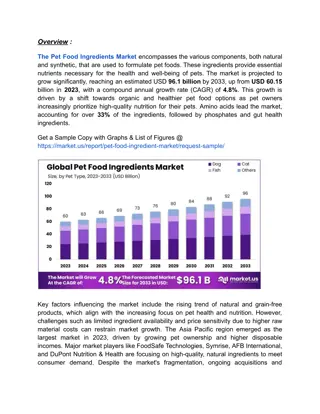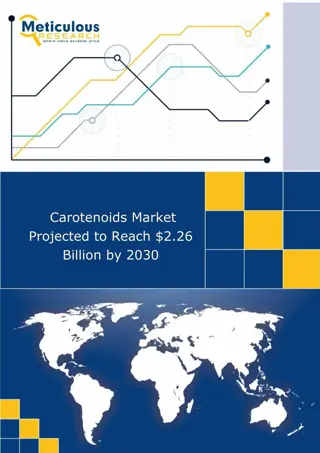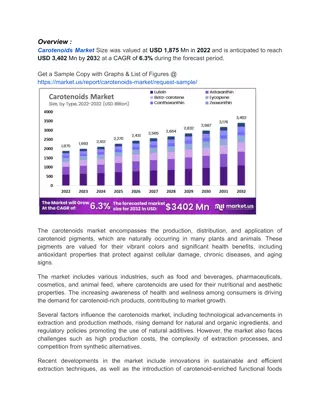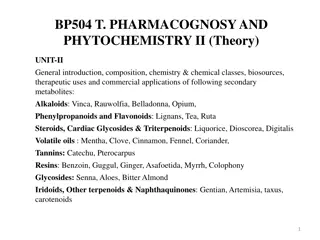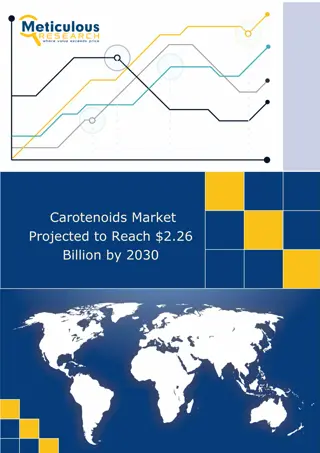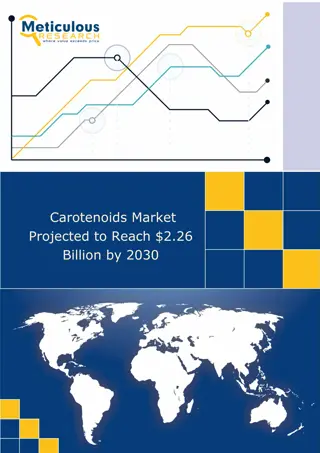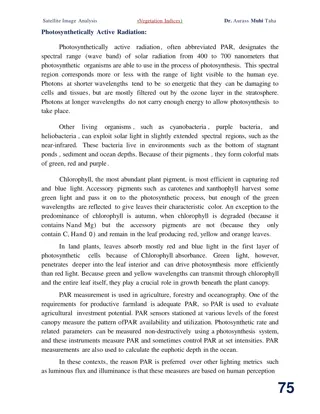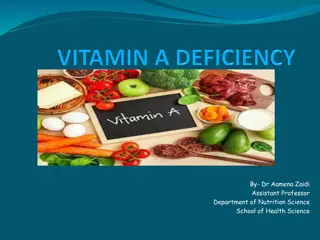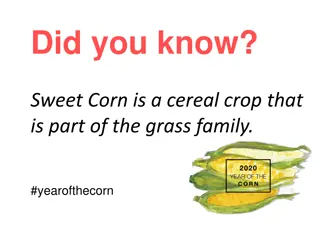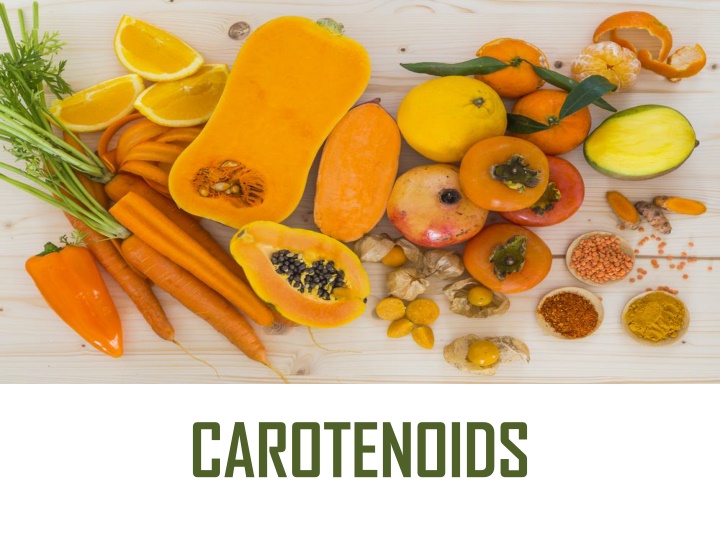
The Health Benefits of Carotenoids in Foods
Discover the significance of carotenoids in fruits and vegetables, their antioxidant properties, conversion to vitamin A, and potential health benefits. Learn about common carotenoids, rich food sources, and how they work in the body.
Uploaded on | 2 Views
Download Presentation

Please find below an Image/Link to download the presentation.
The content on the website is provided AS IS for your information and personal use only. It may not be sold, licensed, or shared on other websites without obtaining consent from the author. If you encounter any issues during the download, it is possible that the publisher has removed the file from their server.
You are allowed to download the files provided on this website for personal or commercial use, subject to the condition that they are used lawfully. All files are the property of their respective owners.
The content on the website is provided AS IS for your information and personal use only. It may not be sold, licensed, or shared on other websites without obtaining consent from the author.
E N D
Presentation Transcript
CAROTENOIDS Carotenoids are plant pigments responsible for bright red, yellow and orange hues in many fruits and vegetables. These pigments play an important role in plant health. People who eat foods containing carotenoids get protective health benefits as well.
CAROTENOIDS Carotenoids also act as antioxidants in the human body. They have strong cancer-fighting properties, according to the Physicians Committee for Responsible Medicine. Some carotenoids are converted by the body to vitamin A, which is essential to vision and normal growth and development. Carotenoids also have anti- inflammatory and immune system benefits and are sometimes associated with cardiovascular disease prevention.
The Carotenoid family There are more than 600 types of carotenoids. The most common ones in the Western diet, and the most studied, are alpha-carotene, beta-carotene, beta-cryptoxanthin, lutein, zeaxanthin and lycopene, according to the Linus Pauling Institute. There are two broad classifications of carotenoids: carotenes and xanthophylls, said Premkumar. The difference between the two groups is chemical: xanthophylls contain oxygen, while carotenes are hydrocarbons and do not contain oxygen. Also, the two absorb different wavelengths of light during a plant s photosynthesis process, so xanthophylls are more yellow while carotenes are orange.
Most common carotenoids include alpha carotene beta carotene beta cryptoxanthin lutein zeaxanthin lycopene
Foods rich in carotenoids include: Yams Kale Spinach Watermelon Cantaloupe Bell peppers Tomatoes Carrots Mangoes Oranges
Types of Carotenoids alpha carotene. beta carotene. beta cryptoxanthin. lutein. zeaxanthin. lycopene
How do carotenoids work? Carotenoids are fat-soluble compounds, meaning they are best absorbed with fit. Unlike some protein-rich foods and vegetables, cooking and chopping carotenoid-rich foods increase the strength of the nutrients when they enter the bloodstream. Carotenoids are classified into two main groups: xanthophylls and carotenes.
How do carotenoids work? Both types of carotenoids have antioxidan properties. In addition, some carotenoids can be converted into vitamin A, an essential component for human health and growth. These provitaminA carotenoids include alpha carotene, beta carotene, and beta cryptoxanthin. Non- provitaminA carotenoids include lutein, zeaxanthin, and lycopene
Foods that naturally contain carotenoids include: Carrots Mangoes Tomatoes Sweet potatoes Spinach Apricots Tangerines Plantain Turnip greens
Carotenoids in Cardiovascular Pathophysiology of many chronic and acute conditions, especially of CVD, is explained by inflammation and oxidative stress. Apart from sex, age, and genetic factors which cannot be modified, lifestyle and dietary intervention can be considered as new important means of prevention and treatment of cardiovascular risk factors. Whilst it would be beneficial not only to practice regular physical exercise, quit smoking, and reduce sodium and cholesterol , a higher dietary introduction or supplementation of antioxidant compounds, such as polyphenols, vitamins, and carotenoids would also be beneficial.
Carotenoids in Cardiovascular Numerous evidences confirmed that carotenoids possess antioxidant biological properties due to their chemical structure and interaction with biological membranes. In particular, fucoxanthin, astaxanthin, lycopene, and lutein are strong FRs, quenchers of ROS, and NOS, so that their antioxidant and antinflammatory activity may help against cardiovascular risk factors such as markers of inflammation, hyperlipidemia, hypertension, insulin resistance, and obesity.
Carotenoids in Cardiovascular Consequent improvements in blood pressure baseline levels, reduction of inflammation, and correction of dyslipidemias can lead to an improvement of cardiovascular health. Further in-depth efforts in this sense could be studied to define a preventive and therapeutic strategy in order to reduce the risk of developing CVD, with promising applications and no side effects
The increased intake of fruit and vegetables is associated with lower mortality from all causes and with protective effects against CVD [19 21]. Great importance is attributed to the lifestyle improvement: abolition of tobacco use, increase in physical activity and the assumption of a healthy diet, based on high consumption of monounsaturated fats, fruit (rich in vitamins), vegetable fibres, olive oil, and cereals [22 24].
It has been demonstrated that higher serum levels of carotenoids were associated with decreased risk of elevated serum NT-pro BNP levels, suggesting a role in preventing cardiac overload; moreover, high plasma levels of - cryptoxanthin and lutein were associated with lower risk of acute myocardial infarction.
Several researchers have analyzed the influence of evaluated as an increase of intima-media thickness of the common carotid artery (CCA-IMT) in middle-aged men, while in healthy subjects an independent inverse relationship between serum levels of lycopene and brachial-ankle pulse wave velocity was found, considered as a marker of arterial stiffness [27, 28]. A recent 7-year follow-up study shows that high plasma levels of carotenoids protect against early vascular alterations assessed by CCA-IMT: changes in IMT was inversely associated with concentrations of lycopene, - carotene, and -carotene.
Patients with coronary artery disease showed to have lower plasma levels of lutein, zeaxanthin, - cryptoxanthin, -carotene, - carotene, and lycopene compared to healthy subjects; moreover, the reduced levels of lutein, zeaxanthin, and -cryptoxanthin were associated with smoking, high body mass index, and low high-density lipoprotein cholesterol (HDL-C)





